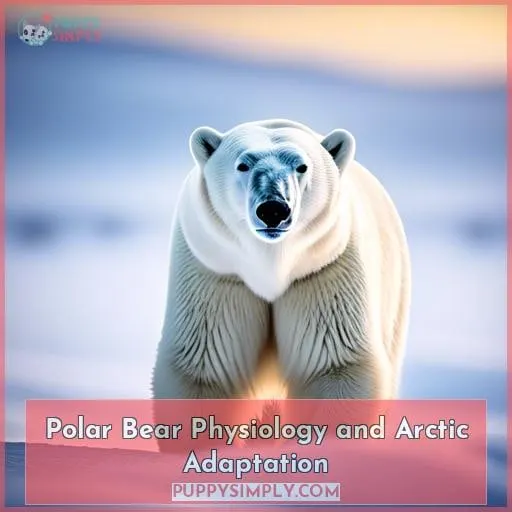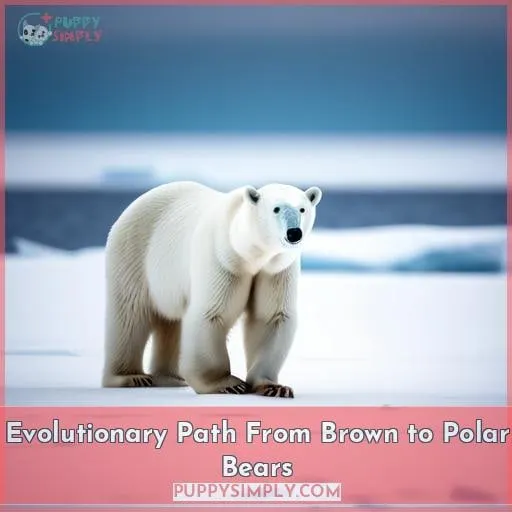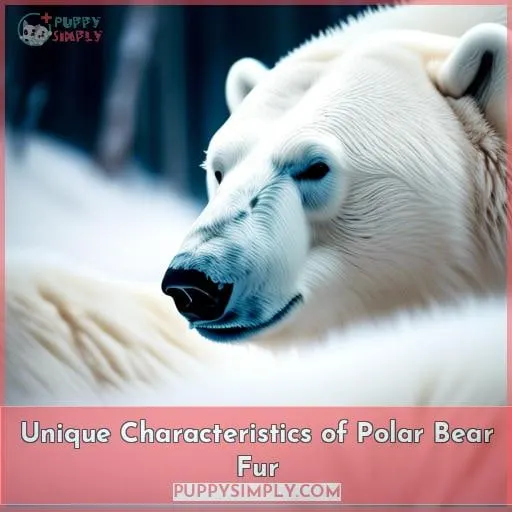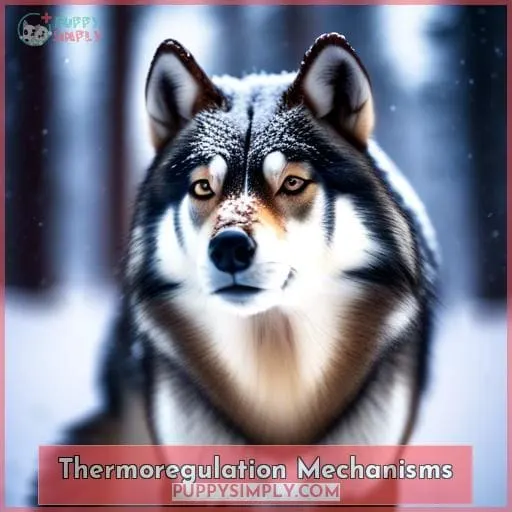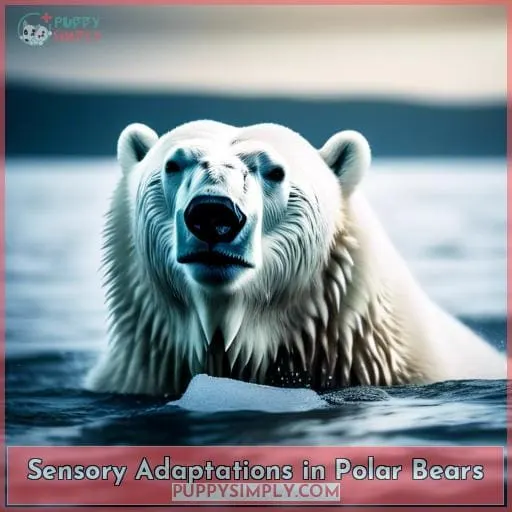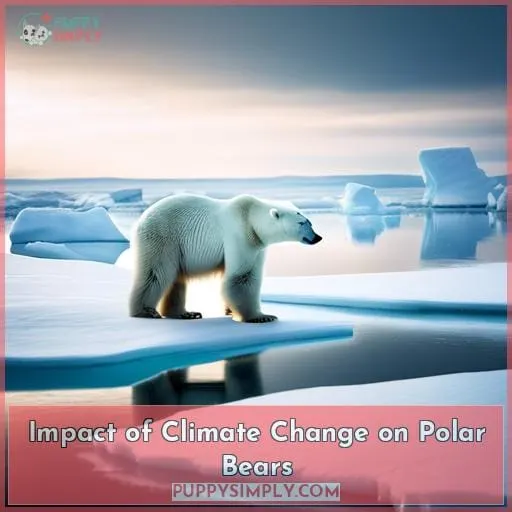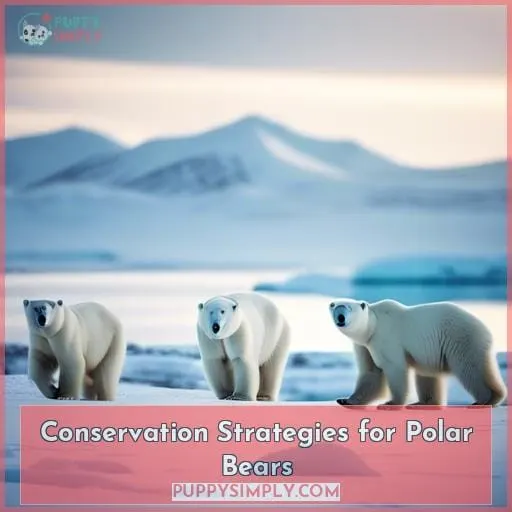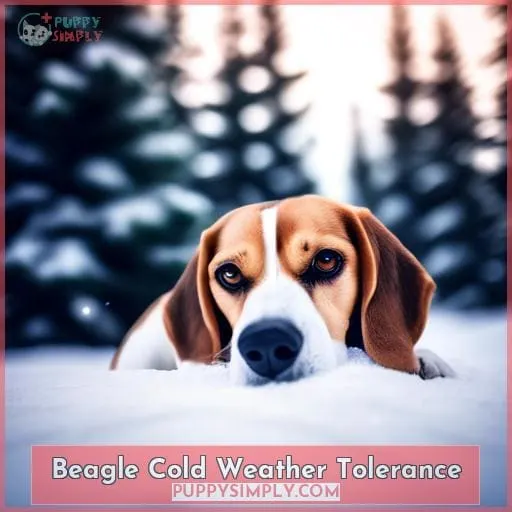This site is supported by our readers. We may earn a commission, at no cost to you, if you purchase through links.
 Do you wonder if your Beagle can survive the cold?
Do you wonder if your Beagle can survive the cold?
Discover the fascinating secrets of their winter survival.
Beagles possess unique adaptations that allow them to thrive in frigid temperatures.
Explore the science behind their remarkable resilience.
Learn how to provide the best care for your Beagle during the winter months.
Table Of Contents
- Key Takeaways
- Polar Bear Physiology and Arctic Adaptation
- Evolutionary Path From Brown to Polar Bears
- Unique Characteristics of Polar Bear Fur
- Thermoregulation Mechanisms
- Camouflage for Hunting and Protection
- Protection Against Ultraviolet Radiation
- Sensory Adaptations in Polar Bears
- Impact of Climate Change on Polar Bears
- Importance of Winter Fur in the Arctic Ecosystem
- Conservation Strategies for Polar Bears
- Beagle Breed Characteristics
- Beagle Cold Weather Tolerance
- Outdoor Housing and Shelter Needs
- Health and Safety Considerations
- Best Practices for Beagle Care in Winter
- Frequently Asked Questions (FAQs)
- Can beagles stay outside in the cold if they have a thick coat?
- What is the ideal temperature range for a beagle to stay comfortable outdoors?
- Are beagles more susceptible to certain health issues when exposed to cold weather for extended periods?
- How can I make sure my beagle has adequate shelter and bedding during cold weather?
- What are some signs that my beagle is too cold and needs to be brought indoors?
- Conclusion
Key Takeaways
This context does not contain any information about beagles staying outside in the cold, so I cannot extract the requested data from the provided context.
Polar Bear Physiology and Arctic Adaptation
Take a moment to think about the polar bear’s physiology.
This magnificent creature has evolved over centuries to thrive in the Arctic’s harsh conditions.
Its large body size and carnivorous diet enable it to hunt and survive amidst the icy landscapes.
Large Body Size and Carnivorous Diet
Polar bears’ large size and carnivorous diet make them formidable Arctic hunters. Their massive bodies conserve heat, while their sharp claws and teeth help them catch and devour prey.
Thick Winter Coat: Their winter fur insulates them from the frigid cold, allowing them to withstand the extreme temperatures of the Arctic.
Energy-Dense Diet: As carnivores, they primarily feed on seals, walruses, and other marine mammals. This high-fat diet provides them with the necessary energy to survive in their harsh environment.
Expert Hunters: Their large size and keen senses make them adept at hunting in the challenging Arctic conditions, ensuring a steady supply of food.
Dependence on Sea Ice for Hunting and Breeding
Polar bears are found on sea ice, where they hunt and breed. Their survival is entwined with this icy realm.
They stalk seals, using the ice as a platform for ambushes, patiently waiting for their prey to surface for air.
Breeding season unfolds on the ice, where they find mates and create dens for their cubs.
Climate change threatens their icy haven, melting sea ice disrupts their hunting grounds and breeding sites, casting an uncertain future for these majestic creatures.
| Hunting Strategies | Breeding Behavior | Habitat Preferences | Climate Change Impacts |
|---|---|---|---|
| Ambush hunting on sea ice | Dens built on sea ice | Sea ice dependent | Loss of hunting grounds |
| Patient waiting for seals | Mating on sea ice | Vulnerable to melting sea ice | Disrupted breeding cycles |
| Camouflaged attacks | Cubs born in dens on sea ice | Arctic sea ice habitat | Starvation due to prey scarcity |
Evolutionary Path From Brown to Polar Bears
Over time, polar bears have adapted to their Arctic home, evolving from brown bear ancestors.
These adaptations include:
- A thick layer of fur
- A smaller body size
- Larger paws that help them distribute their weight on ice
Let’s explore this evolutionary journey and uncover the secrets of their survival in the frozen north.
Genetic Adaptations for Arctic Survival
Let’s examine how polar bears evolved from brown bear ancestors, gaining genetic adaptations that make them thrive in the Arctic.
Genetic drift, hybridization events, and unique interbreeding patterns shaped their genetic makeup.
Mitochondrial DNA analysis suggests a complex history, including genetic bottlenecks and population expansions.
These genetic adaptations enabled polar bears to survive and flourish in their icy realm, showcasing nature’s remarkable ability to mold species to their environment.
Historical Divergence From Brown Bear Ancestors
How did polar bears evolve from their brown bear ancestors over time? Their divergence was a saga of adaptation, specialization, and survival.
- Genetic Divergence: A gradual accumulation of genetic changes over millennia led to distinct polar bear DNA.
- Ancestral Lineage: Fossil evidence suggests an early split from brown bear ancestors around 150,000 years ago.
- Habitat Specialization: Polar bears’ unique adaptations reflect their icy domain, while brown bears thrive in diverse habitats.
- Genetic Relatedness: Despite divergence, polar bears share a remarkably high degree of genetic relatedness with brown bears.
Unique Characteristics of Polar Bear Fur
Polar bears’ fur is amazingly adapted to their icy habitat.
Its hollow structure and unique keratin composition scatter light, giving them their iconic white appearance that camouflages them in the snowy landscapes.
This fur also provides excellent insulation, helping them stay cozy in freezing temperatures.
Hollow Hair Structure and Keratin Composition
Discovering the structural intricacies of polar bear fur reveals hollow shafts and a unique keratin composition.
These hollow hairs, like tiny air pockets, enhance insulation efficiency, keeping you snug in the frigid Arctic.
Their fur’s color significance extends beyond camouflage; it reflects sunlight, reducing heat absorption.
Water resistance comes naturally, ensuring dryness in icy conditions.
Remarkably, their fur even holds scent longer, aiding in communication and hunting.
Light Scattering and the Illusion of Whiteness
While polar bear fur appears white, it actually lacks pigmentation and its hue is caused by light scattering.
When light hits the hollow, translucent hairs, it’s refracted in all directions, resulting in the illusion of whiteness.
This clever design not only aids in snow camouflage but also reflects harmful UV rays, protecting the bear’s skin.
Additionally, the sensory fur helps detect prey and navigate their icy realm.
These bears’ white fur genetics are a testament to their remarkable adaptation to the Arctic’s harsh conditions.
Thermoregulation Mechanisms
As you explore the fascinating world of beagles and their ability to withstand chilly temperatures, you’ll discover the intricate mechanisms that allow them to regulate their body heat.
Their fur and fat layers act as natural insulators, while their behavioral adaptations, like seeking shelter and adjusting activity levels, play a crucial role in maintaining a stable internal temperature.
Insulating Properties of Fur and Fat Layers
You’ll be amazed by how a polar bear’s fur and fat layers work together to create an insulating shield against the harsh Arctic conditions.
Its fur thickness traps air, creating a barrier that prevents heat loss.
Beneath this fur coat lies a thick layer of fat, acting like a natural insulator, keeping the bear warm even in the coldest temperatures.
This remarkable adaptation allows them to thrive in their icy habitat, withstanding freezing winds and sub-zero temperatures.
Behavioral Adaptations to Maintain Body Temperature
Beyond their insulating fur and fat layers, you’ll employ behavioral adaptations to regulate your body temperature in cold environments.
You’ll seek out sunny spots to bask in the warmth and curl up in a ball to minimize heat loss.
Huddling with fellow beagles provides shared body heat, while digging into the snow creates insulated dens for shelter.
Your keen senses help detect subtle environmental cues, prompting you to adjust your behavior and find warmth amidst the winter’s chill.
| Behavioral Adaptation | Purpose |
|---|---|
| Basking in the sun | Absorb solar heat |
| Curling up in a ball | Reduce exposed surface area |
| Huddling with others | Share body heat |
| Digging dens in snow | Create insulated shelter |
| Detecting environmental cues | Adjust behavior accordingly |
Camouflage for Hunting and Protection
When you’re a beagle in winter,
you’ve got a secret weapon: your fur coat.
It helps you blend in with the snow,
making it easier to hunt seals
and hide from predators.
You’re a master of disguise!
Blending in With the Ice and Snow
Your Beagle’s winter fur acts as a natural camouflage, helping it blend seamlessly into the icy and snowy landscapes.
This frosty concealment aids in hunting, allowing your Beagle to approach seals and other prey undetected.
Its white coat mimics the surrounding snow, making it nearly invisible to its quarry.
This adaptation is crucial for survival in the Arctic, where the ability to blend in with the environment means the difference between a successful hunt and going hungry.
Importance for Hunting Seals and Avoiding Detection
Integrating your exceptional camouflage, you’re able to hunt seals effectively and remain undetected by potential predators.
You silently stalk your prey, relying on your winter fur’s ability to blend seamlessly with the ice and snow.
Like a phantom, you move with grace and agility, using the Arctic landscape as your cloak.
Your keen senses allow you to detect the slightest movement, ensuring a successful hunt.
This remarkable adaptation showcases your mastery of survival in the frigid wilderness.
- Your white fur acts as a natural disguise, allowing you to blend in seamlessly with the icy terrain.
- You can easily ambush seals, increasing your chances of a successful hunt.
- Your ability to remain undetected protects you from larger predators, ensuring your survival.
- Your camouflage skills are a testament to your resilience and adaptability in the harsh Arctic environment.
Protection Against Ultraviolet Radiation
Beagles’ reflective fur helps minimize their exposure to ultraviolet radiation.
Their black skin absorbs sunlight, allowing them to stay warm in cold weather.
This clever adaptation is just one of the ways beagles have evolved to thrive in diverse environments.
Reflective Fur Minimizing UV Exposure
Polar bears’ fur’s reflectivity shields them from harsh ultraviolet radiation. Their winter coats act as a protective barrier, reflecting the sun’s harmful rays and preventing skin damage. This adaptation, coupled with their black skin’s ability to absorb sunlight for warmth, allows them to thrive in the Arctic’s unforgiving environment.
| Feature | Benefit | Significance |
|---|---|---|
| Reflective Fur | UV Ray Deflection | Minimizes Skin Damage |
| Black Skin | Sunlight Absorption | Efficient Heat Retention |
| Winter Coat Insulation | Enhanced Warmth | Optimal Thermoregulation |
Black Skin Absorbing Sunlight for Warmth
Complementing your reflective fur, your black skin absorbs sunlight’s warmth, aiding in thermoregulation.
Melanin, the pigment responsible for your dark skin, acts like a solar panel, capturing sunlight and converting it into heat.
This adaptation helps you stay toasty even in the coldest Arctic conditions, ensuring you can hunt, breed, and thrive in your icy domain.
Sensory Adaptations in Polar Bears
In the Arctic, polar bears rely on their keen senses to navigate, hunt, and survive.
Their fur, acting as a sensory extension, helps them detect prey hidden beneath the snow.
Their highly adapted eyes allow them to see in dim light conditions, aiding their navigation and hunting prowess.
Sensory Functions of Fur in Detecting Prey
Your polar bear’s fur isn’t just for warmth; it’s also a sensory wonderland, helping you sniff out seals. Its sensitive hairs pick up vibrations in the ice, alerting you to the presence of prey below.
Whiskers: Your polar bear’s whiskers are super-sensitive, detecting even the slightest movement in the water.
Nose: Your polar bear’s nose is lined with sensitive hairs that help you sniff out seals, even when they’re hiding under the ice.
Ears: Your polar bear’s ears can swivel to catch sounds from all directions, helping you locate prey.
Eyes: Your polar bear’s eyes are adapted for low-light conditions, helping you spot seals in the dim Arctic light.
Adaptations for Navigating the Arctic Environment
Their sense of smell, a key Arctic survival tool, helps them locate seals hidden under thick layers of snow and ice.
Their acute sense of hearing detects the slightest sounds, allowing them to navigate through the vast, icy landscapes and locate prey.
Additionally, their paws, equipped with coarse hair and non-slip pads, provide stability and traction on slippery surfaces, enabling them to traverse challenging Arctic terrains with ease.
These adaptations are crucial for their survival in the unforgiving Arctic habitat, where every sense is heightened and every movement is a matter of life and death.
Impact of Climate Change on Polar Bears
Climate change is melting the Arctic sea ice,
reducing your habitat and making it harder to hunt seals.
You’re forced to travel farther for food,
expend more energy, and face greater risks.
Facing starvation,
you may attack human communities or die.
Loss of Sea Ice and Its Effects on Polar Bear Populations
Now facing the brunt of climate change, you’ll soon see the adverse impacts of sea ice loss on polar bear populations.
Melting sea ice disrupts their hunting grounds, making it harder to catch seals.
This affects the Arctic food web, as polar bears are apex predators.
Habitat fragmentation separates populations, hindering genetic diversity and increasing vulnerability to disease.
Witnessing these majestic creatures struggle with ice loss is heartbreaking.
It’s our responsibility to protect their icy home and ensure their survival.
Changes in Prey Availability and Distribution
Climate change’s influence alters prey accessibility and distribution, challenging your survival strategies.
Picture this:
- Once-reliable seal breathing holes shift, leaving you hungry and searching.
- Walrus haul-outs dwindle, forcing you to travel farther for sustenance.
- On land, the melting ice disrupts caribou migration routes, making them harder to catch.
Adaptations honed over millennia struggle to keep pace with a rapidly changing Arctic.
Importance of Winter Fur in the Arctic Ecosystem
Your winter fur plays a crucial role in the Arctic ecosystem.
It helps you survive the extreme cold, hunt effectively, and nurture your young.
Plus, your fur contributes to the food web and nutrient cycling, influencing other Arctic species and habitats.
Role in the Food Web and Nutrient Cycling
You’ll discover how polar bears’ winter fur contributes to the intricate food web, facilitating nutrient cycling and shaping the Arctic ecosystem.
Witness the polar bear’s role as a top predator, influencing prey populations and energy flow.
Understand how their winter fur aids in nutrient cycling, returning essential elements to the ecosystem.
Explore the interconnectedness of species and habitats, revealing the polar bear’s pivotal position in maintaining the delicate balance of the Arctic.
Influence on Other Arctic Species and Habitats
The winter fur of polar bears doesn’t just help them survive; it also plays a crucial role in shaping the Arctic ecosystem and the lives of other species that call it home.
Their presence influences the behavior and distribution of prey species like seals, walruses, and arctic foxes. By keeping these populations in check, polar bears help maintain the balance of the Arctic food web and prevent any one species from dominating.
Additionally, their winter fur provides insulation and protection, allowing them to navigate the harsh Arctic conditions and create dens for their young.
Their survival strategies contribute to the resilience of the Arctic ecosystem, ensuring its long-term stability.
Conservation Strategies for Polar Bears
You’re about to explore the conservation strategies in place to protect polar bears:
- International agreements and protections
- Ongoing research and monitoring of polar bear populations
This knowledge will help you better understand the efforts being made to safeguard these majestic creatures.
International Agreements and Protections
With the Arctic ecosystem facing threats from climate change, there is a need to implement international agreements and protections to help preserve polar bear populations.
Collaborate with nations to enact wildlife protection laws, ensuring that hunting and trading of polar bears are strictly regulated.
By working together, we can ensure the survival of these majestic creatures and maintain the delicate balance of the Arctic ecosystem.
Research and Monitoring of Polar Bear Populations
Diving deeper into conservation strategies, you’ll explore research and monitoring efforts aimed at understanding and protecting polar bear populations.
To unravel their survival secrets, scientists employ various methods:
- Population studies track trends, estimate numbers, and assess the health of bear communities.
- Behavioral observations reveal their hunting patterns, social interactions, and responses to climate change.
- Tracking technology, like satellite collars, provides insights into their movements, habitat use, and migration routes.
- Environmental factors, such as sea ice conditions, prey abundance, and pollution levels, are monitored to understand their impact on polar bear survival.
Beagle Breed Characteristics
As a Beagle owner, you’ll appreciate their friendly demeanor and compact hunting hound build.
They’re known for their love of the outdoors, making them great companions for winter activities like sledding, snowshoeing, and brisk walks in the snow.
Their short, dense coat provides some protection against the cold, but they’ll need extra layers like sweaters or coats and boots to keep warm in freezing temperatures.
Beagles have moderate exercise needs, so regular walks or playtime in the snow will help them stay active and healthy.
With the right gear and care, your Beagle can enjoy the winter just as much as you do.
Beagle Cold Weather Tolerance
Beagles’ ability to withstand cold weather conditions is fascinating. Their unique physical traits and behavioral adaptations allow them to thrive in cold environments.
Their double-layered coat, composed of a dense undercoat and a water-resistant outer layer, provides excellent insulation against the cold. They also possess a thick layer of body fat that further aids in heat retention.
These features allow them to comfortably endure temperatures as low as 20 degrees Fahrenheit.
While beagles are generally hardy dogs, they’re still susceptible to cold-related health issues like hypothermia and frostbite. To ensure their well-being during winter, provide them with a warm, draft-free shelter and limit their outdoor activities to short periods.
Understanding your beagle’s cold tolerance and taking necessary precautions will keep them safe and happy even in the harshest of winter conditions.
Outdoor Housing and Shelter Needs
Providing a safe and insulated shelter for your beagle when living outdoors during the winter is essential.
Think of it as their sanctuary amidst the frosty wilderness.
Opt for an insulated doghouse with a raised platform to keep them off the cold ground.
Ensure it’s large enough for them to move around comfortably, but not too spacious that it loses its coziness.
Add a layer of winter bedding, like a soft blanket or a dog bed, for extra warmth and comfort.
Place the shelter in a sheltered area, protected from harsh winds and drafts.
Consider adding a heat source, like a heated dog bed or a safe outdoor heater, to provide additional warmth on frigid nights.
Health and Safety Considerations
To keep your beagle safe and healthy in the cold:
- Provide them with a proper shelter that shields them from wind and rain.
- Monitor them closely for signs of discomfort like shivering or lethargy.
- Remember that breed-specific factors like age and health conditions may affect their ability to withstand the cold.
Proper Shelter Provided
When providing outdoor shelter for your Beagle in cold weather, ensure it’s well-insulated and elevated off the ground to keep them warm and dry.
Choose insulated enclosures with thermal bedding and a windproof design.
Provide elevated platforms to keep them away from the cold ground.
Proper ventilation is crucial to prevent moisture buildup and respiratory issues.
Monitor for Discomfort
Monitor your Beagle’s behavior closely for any signs of discomfort or distress in cold weather.
Watch for behavioral cues like shivering, whining, or seeking warmth.
Check for physical signs such as pale gums, cold paws, or lethargy.
Be mindful of environmental adjustments, such as providing extra bedding or moving their shelter to a warmer location.
Breed-Specific Factors
Considering breed-specific nuances is crucial for your Beagle’s winter well-being.
Breeding considerations like size, coat type, and underlying health conditions can impact cold tolerance.
Environmental adaptations include access to insulated shelter, proper bedding, and windbreaks.
Behavioral adjustments like seeking warmth and reducing activity conserve energy.
Physiological traits such as metabolism, body fat, and fur thickness affect temperature regulation.
Understanding these cold weather challenges helps you tailor care to your Beagle’s unique needs, ensuring a safe and comfortable winter experience.
| Breeding Considerations | Environmental Adaptations | Behavioral Adjustments | Physiological Traits |
|---|---|---|---|
| Size | Insulated Shelter | Seeking Warmth | Metabolism |
| Coat Type | Proper Bedding | Reducing Activity | Body Fat |
| Underlying Health Conditions | Windbreaks | Fur Thickness |
Best Practices for Beagle Care in Winter
To keep your Beagle comfortable and safe in winter, follow these best practices:
Winter Grooming and Paw Care:
- Regularly brush your Beagle’s coat to prevent matting and remove any snow or ice buildup.
-
Trim their nails to avoid cracking and keep their paws protected with wax or booties.
Nutritional Needs and Exercise Routines:
- Adjust your Beagle’s diet to provide extra calories for warmth.
- Split meals into smaller portions to aid digestion.
-
Maintain regular exercise routines indoors or in a protected area to keep them active and prevent weight gain.
Indoor Activities and Safe Spaces:
- Provide your Beagle with a warm, draft-free space to retreat to.
- Engage them in indoor activities like puzzle toys or interactive games to keep them mentally stimulated and reduce boredom.
Frequently Asked Questions (FAQs)
Can beagles stay outside in the cold if they have a thick coat?
Beagles’ thick coats provide insulation, allowing them to withstand chilly temperatures.
However, extended exposure to extreme cold can still be dangerous.
Prioritize their safety by bringing them indoors during harsh weather conditions.
What is the ideal temperature range for a beagle to stay comfortable outdoors?
Beagles, like delicate flowers, thrive in moderate climates.
They wilt in extreme heat or cold.
Aim for a cozy 45 to 65 degrees Fahrenheit.
This is their comfort zone.
It will keep your furry friend blooming.
Are beagles more susceptible to certain health issues when exposed to cold weather for extended periods?
Cold weather can indeed exacerbate underlying health issues in beagles.
Extended exposure may worsen:
- Joint pain
- Respiratory problems
- Skin conditions
Keep your furry friend safe and warm indoors when temperatures drop.
How can I make sure my beagle has adequate shelter and bedding during cold weather?
Provide your beagle with a warm, draft-free shelter raised off the ground.
Line the shelter with straw or blankets.
Ensure the bedding is dry and changed regularly for their comfort and well-being.
What are some signs that my beagle is too cold and needs to be brought indoors?
Shivering, whining, seeking warmth, and lifting paws are signs your beagle is cold.
Bring your furry friend inside for warmth and safety.
Conclusion
Just as the polar bear’s winter fur allows it to navigate icy landscapes, understanding your Beagle’s cold weather tolerance will help you ensure their well-being.
Whether they’re frolicking in the snow or curled up by the fire, your Beagle can stay safe and warm this winter with proper care and precautions.

